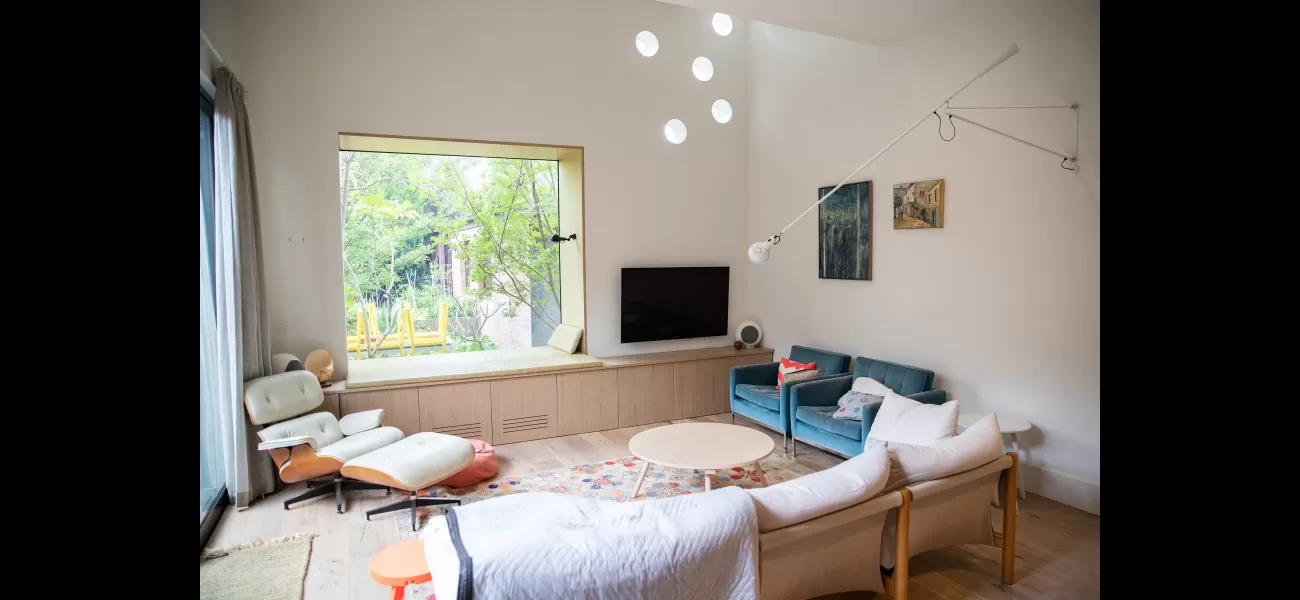Housing trend: smaller houses = good for new buyers
Couple purchases first home after years of saving.
August 6th 2024.

After putting away money for several years, Jordyn Carias and her partner were finally able to fulfill their dream of purchasing a home last month. However, they quickly realized that in order to find a place that fit their budget, they would have to compromise on some of their initial desires. Carias, a graphic designer residing in Muscatine, Iowa, explained that they had to downsize their expectations and go for a smaller home.
It is no secret that America is known for its larger-than-life cars, portion sizes, and even take-out coffee cups. This trend has also extended to the housing market, with Americans typically seeking out bigger homes. However, times are changing and this is no longer the case. For the past fifty years, the size of new single-family homes has consistently been on the rise. In fact, according to data from the US Census, the median size of new homes in 1973 was 1,525 square feet, while in 2015 it had increased to a whopping 2,467 square feet.
But as the cost of buying a home continues to skyrocket and the once-popular McMansions lose their appeal, homebuilders have started to shift towards building smaller homes to cater to first-time buyers. In 2023, the median size of new single-family homes dropped to 2,233 square feet, marking a 9% decrease from the peak in 2015. This has led to the disappearance of formal dining rooms and "bonus" rooms in many homes, as builders focus on maximizing space.
Carias and her partner ended up settling for a home that is approximately 920 square feet. To make the most of their space, they decided to use the basement as their main bedroom. According to Alan Ratner, an analyst at Zelman & Associates, this shift towards smaller homes is a result of the challenging affordability in the housing market. It is no longer about what consumers want and demand, but rather a necessity.
Interestingly, homebuyers are now showing a preference for smaller dwellings. A study by the National Association of Homebuilders revealed that the average buyer now wants a home that is 2,067 square feet, which is still smaller than the typical new home size from last year.
Looking back, it is evident that the concept of suburban living in America has shifted over the years. In the late 1940s, the "Levittown" homes became synonymous with suburban life in post-war America. These developments, initially located in the New York suburbs but eventually spreading across the country and Puerto Rico, usually consisted of eight homes on one acre, each measuring around 750-800 square feet. However, as Americans became wealthier, there was a growing demand for larger homes and higher living standards, resulting in a continuous increase in the size of new homes.
Today, it is rare to find smaller homes under 1,000 square feet in most US suburbs. According to Jacob Anbinder, a historian at Cornell University, most of the original Levittown homes have been demolished or expanded over the years to make room for larger spaces. However, there has been a shift in recent years, with 17% of homebuilders reporting that they built homes on smaller lots in 2023 to make them more affordable. Additionally, 14% of builders said they focused on constructing townhouses.
One of the biggest homebuilders in America, D.R. Horton, has also recognized the need for smaller homes and announced plans to reduce the size of their homes to cater to homebuyers' affordability concerns. In fact, their average house size has already decreased by 2% compared to last year. This is good news for potential buyers, as the median sales price for existing homes has increased to $426,900, while new homes' median price in June was $417,300.
As a Realtor specializing in selling new constructions, Heather Eisenmann has noticed a significant shift in the market. She has observed that many new homes now have smaller bedrooms and living rooms, with some even lacking freestanding tubs to save on bathroom space. Formal dining rooms are also being replaced by kitchen islands designed for bar seating. This trend is particularly prevalent in Clarksville, Tennessee, where Eisenmann operates. She noted that three years ago, homes in a subdivision called Easthaven ranged from 2,500 to 3,200 square feet, but now most homes are under 2,000 square feet.
Eisenmann also highlighted a concerning trend where some homebuilders are cutting back on amenities and expensive appliances to lower the homes' list prices. While this may seem like a good strategy, it could backfire and push away first-time buyers. She explained that the appeal of new constructions is the low maintenance they offer, but when buyers realize that they have to purchase additional appliances, they may turn to existing homes instead.
For Carias, her new home, which was built almost a century ago, is perfect. She and her partner have no plans to move anytime soon, having relocated to her hometown from the Sacramento area to find a more affordable home. She shared that their main goal was to have a place of their own without throwing away money on rent. She is excited to paint and customize their new home as they please.
It is no secret that America is known for its larger-than-life cars, portion sizes, and even take-out coffee cups. This trend has also extended to the housing market, with Americans typically seeking out bigger homes. However, times are changing and this is no longer the case. For the past fifty years, the size of new single-family homes has consistently been on the rise. In fact, according to data from the US Census, the median size of new homes in 1973 was 1,525 square feet, while in 2015 it had increased to a whopping 2,467 square feet.
But as the cost of buying a home continues to skyrocket and the once-popular McMansions lose their appeal, homebuilders have started to shift towards building smaller homes to cater to first-time buyers. In 2023, the median size of new single-family homes dropped to 2,233 square feet, marking a 9% decrease from the peak in 2015. This has led to the disappearance of formal dining rooms and "bonus" rooms in many homes, as builders focus on maximizing space.
Carias and her partner ended up settling for a home that is approximately 920 square feet. To make the most of their space, they decided to use the basement as their main bedroom. According to Alan Ratner, an analyst at Zelman & Associates, this shift towards smaller homes is a result of the challenging affordability in the housing market. It is no longer about what consumers want and demand, but rather a necessity.
Interestingly, homebuyers are now showing a preference for smaller dwellings. A study by the National Association of Homebuilders revealed that the average buyer now wants a home that is 2,067 square feet, which is still smaller than the typical new home size from last year.
Looking back, it is evident that the concept of suburban living in America has shifted over the years. In the late 1940s, the "Levittown" homes became synonymous with suburban life in post-war America. These developments, initially located in the New York suburbs but eventually spreading across the country and Puerto Rico, usually consisted of eight homes on one acre, each measuring around 750-800 square feet. However, as Americans became wealthier, there was a growing demand for larger homes and higher living standards, resulting in a continuous increase in the size of new homes.
Today, it is rare to find smaller homes under 1,000 square feet in most US suburbs. According to Jacob Anbinder, a historian at Cornell University, most of the original Levittown homes have been demolished or expanded over the years to make room for larger spaces. However, there has been a shift in recent years, with 17% of homebuilders reporting that they built homes on smaller lots in 2023 to make them more affordable. Additionally, 14% of builders said they focused on constructing townhouses.
One of the biggest homebuilders in America, D.R. Horton, has also recognized the need for smaller homes and announced plans to reduce the size of their homes to cater to homebuyers' affordability concerns. In fact, their average house size has already decreased by 2% compared to last year. This is good news for potential buyers, as the median sales price for existing homes has increased to $426,900, while new homes' median price in June was $417,300.
As a Realtor specializing in selling new constructions, Heather Eisenmann has noticed a significant shift in the market. She has observed that many new homes now have smaller bedrooms and living rooms, with some even lacking freestanding tubs to save on bathroom space. Formal dining rooms are also being replaced by kitchen islands designed for bar seating. This trend is particularly prevalent in Clarksville, Tennessee, where Eisenmann operates. She noted that three years ago, homes in a subdivision called Easthaven ranged from 2,500 to 3,200 square feet, but now most homes are under 2,000 square feet.
Eisenmann also highlighted a concerning trend where some homebuilders are cutting back on amenities and expensive appliances to lower the homes' list prices. While this may seem like a good strategy, it could backfire and push away first-time buyers. She explained that the appeal of new constructions is the low maintenance they offer, but when buyers realize that they have to purchase additional appliances, they may turn to existing homes instead.
For Carias, her new home, which was built almost a century ago, is perfect. She and her partner have no plans to move anytime soon, having relocated to her hometown from the Sacramento area to find a more affordable home. She shared that their main goal was to have a place of their own without throwing away money on rent. She is excited to paint and customize their new home as they please.
[This article has been trending online recently and has been generated with AI. Your feed is customized.]
[Generative AI is experimental.]
0
0
Submit Comment





